“About the widest open, most flagrantly and shamelessly wicked city for its size in America.”
— Idaho Press, 3 September 1908,
qtd. in Cynthia Powell’s Thesis,
Beyond Molly B’Damn (1994), p. 144.
[soundcloud url=”https://api.soundcloud.com/tracks/174894531″ params=”auto_play=false&hide_related=false&show_comments=true&show_user=true&show_reposts=false&visual=true” width=”100%” height=”450″ iframe=”true” /]
sanborn fire insurance maps of wallace through the years, with brothel locations in purple:
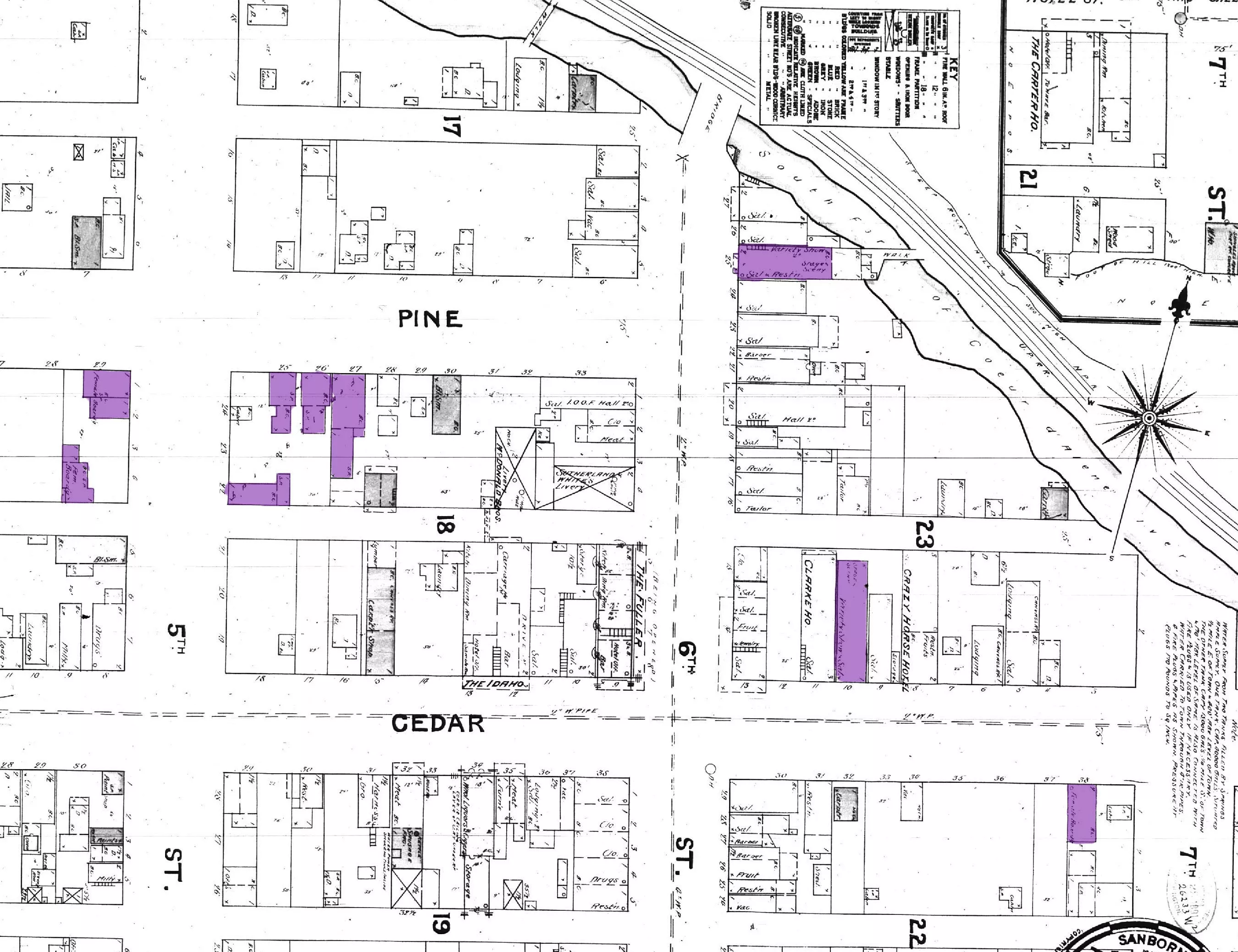
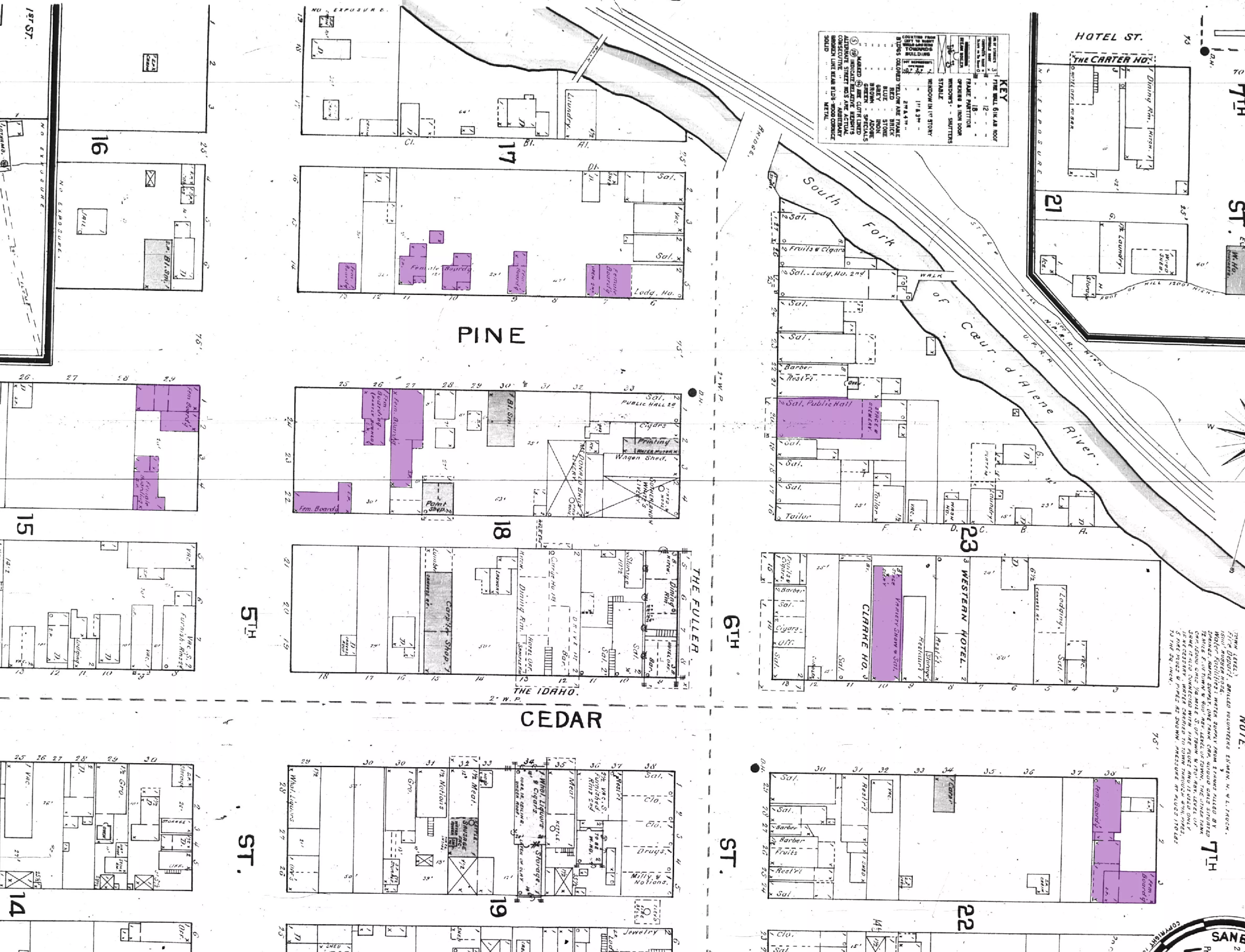
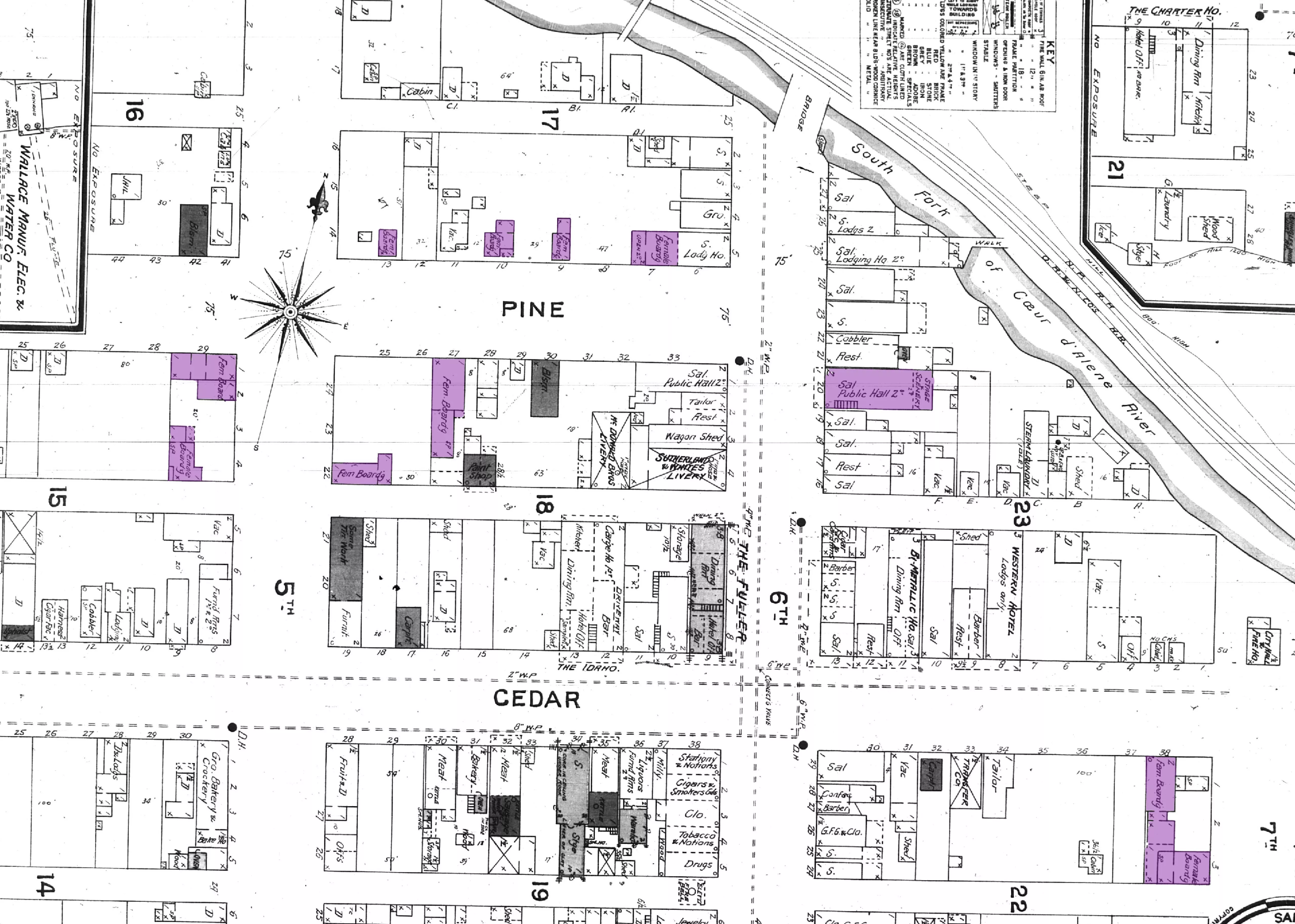


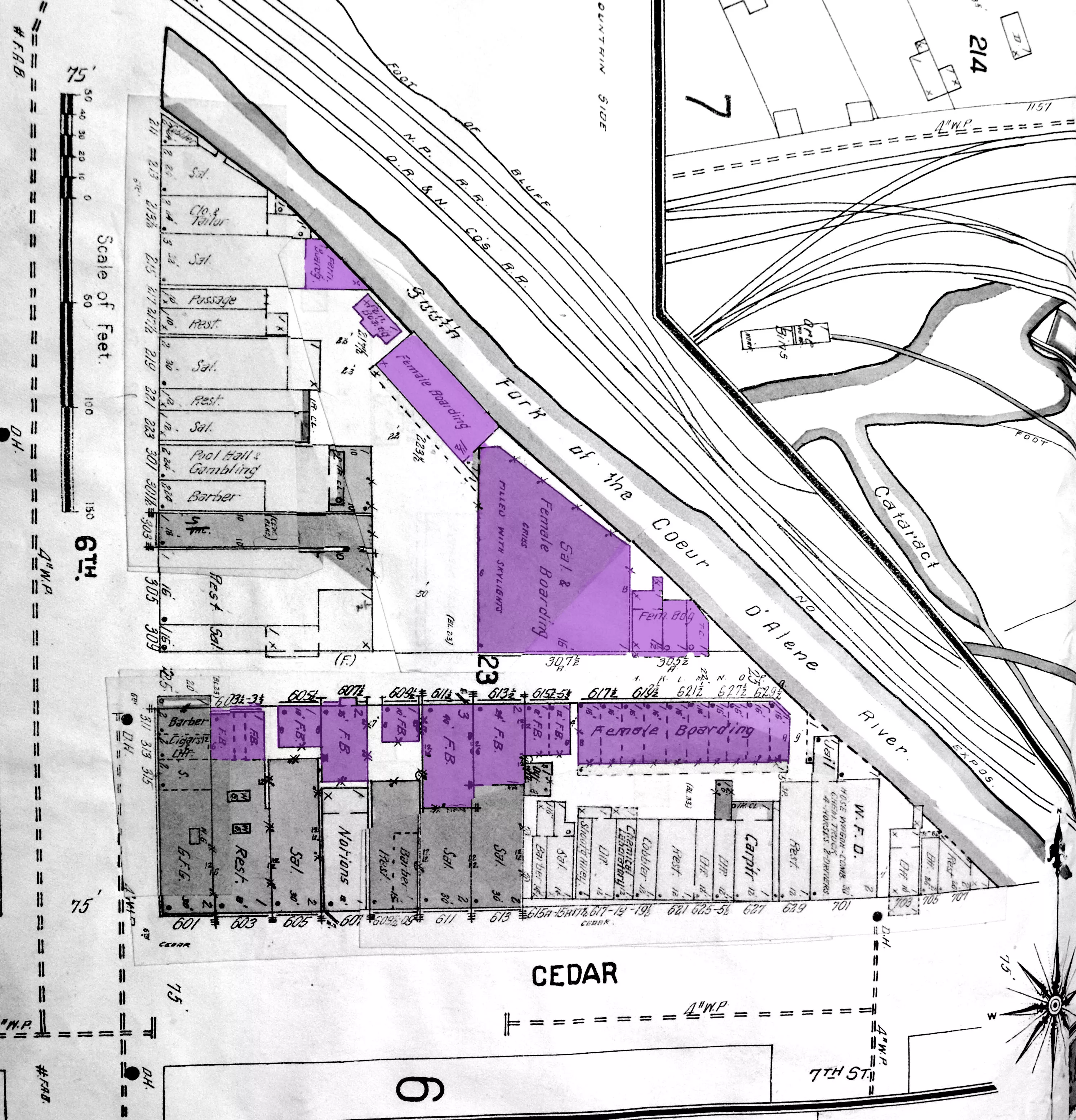


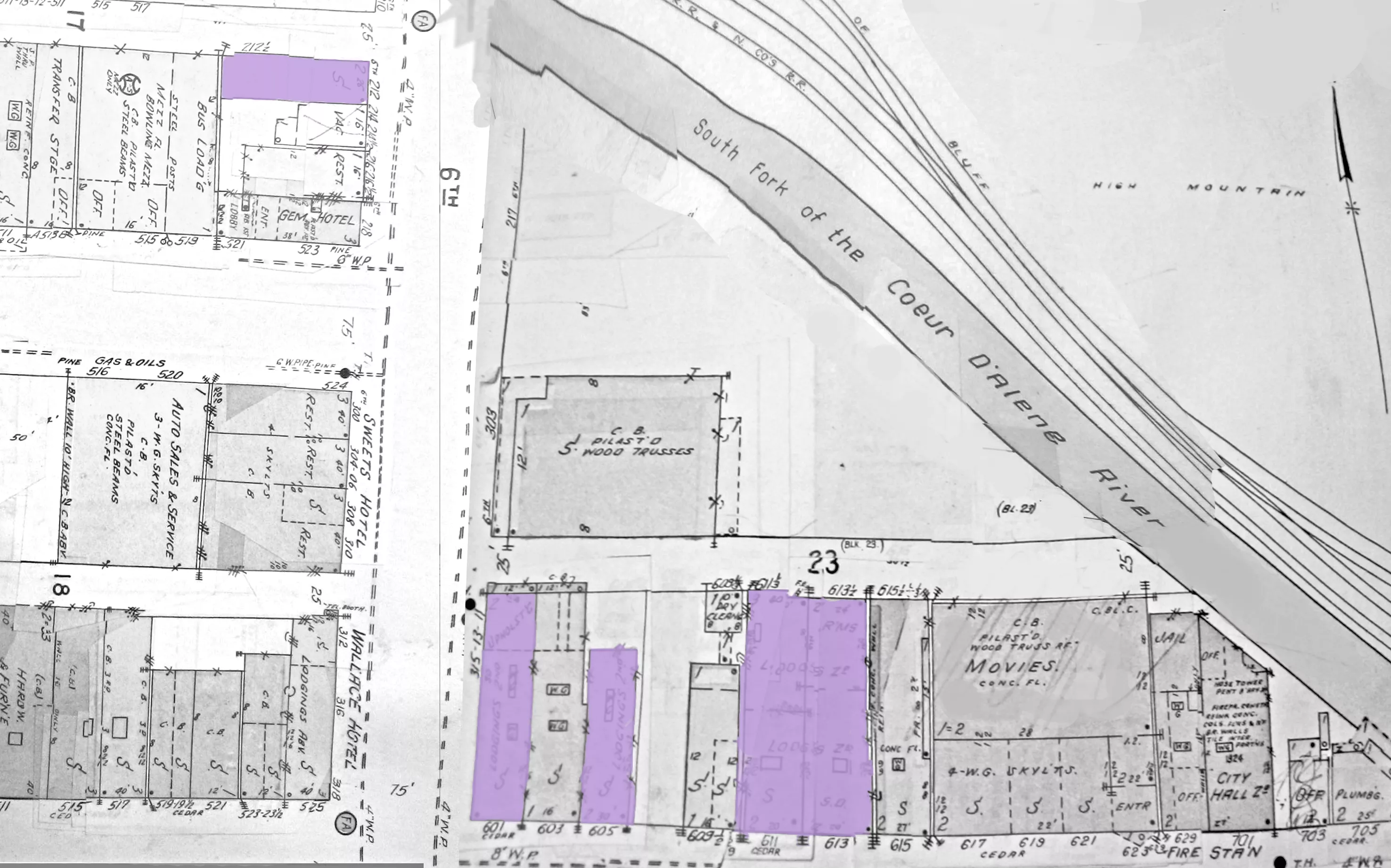
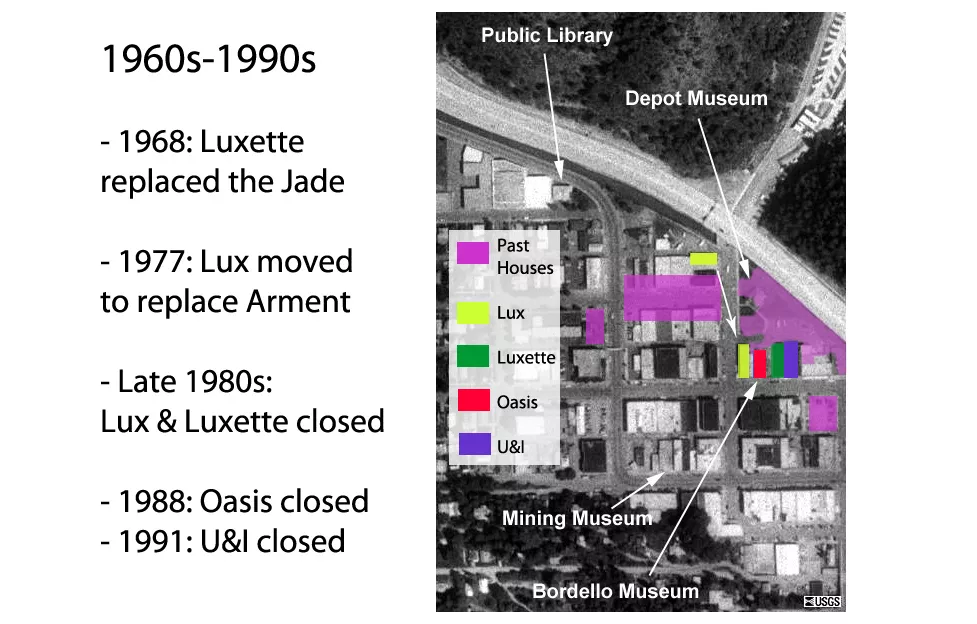
transcript of podcast (and citations–see bibliography page for more information):
By 1891:
‘Liquor licenses were required and several women paid the standard fee of fifty-one dollars for a peimit. In Wallace, Grace Edwards, Ione Skeels (Broncho Liz), Lottie Wilmington, and Lizzie Williams all purchased liquor licenses that year.’[i] The one on the south side of Cedar at 7th was Carrie Young’s house, which was pretty big, comparably, employing eight women, according to Powell.
One of the Pine Street houses’on the southwestern corner of fifth and Pine was The Star, a high-class brothel owned and operated by Gracie Edwards and Jerome B. Smith, who also operated houses in Wardner. The Star on Pine Street [which employed about six women, according to Powell] in Wallace ‘entertained customers in an environment of relaxed luxury.’ Edwards knew how to create ‘the ambiance upper-class brothel patrons required.’[ii]
In 1892:
11-13 women worked in Wallace’s brothels. Nine of those businesses were along Pine Street and they mainly ‘catered to a mining and logging population.’ Between 40-60 women worked in town during this time.[iii]
By 1895, madams were increasingly subjected to arrests and routine fines and ‘several showed up in arrest records between 1893 and 1904. Wallace madams arrested for keeping houses of prostitution included Blanche Burnard, who was arrested four times, Effie Rogan who was arrested five times, and Jessie Stuart who had just one arrest.’[iv]
Between 1896 and 1901:
A large Saloon and Public Hall on the east side of sixth street near the river will turn into “The Coliseum,” operated by Richard Daxon. It actually had a carousel stage, and men watched burlesque entertainment from a horseshoe-shaped gallery.[v] It was the largest of the theaters in town and could probably hold about one hundred people. “The Trilby,” “the Wigwam,” “the Arcade,” and “the Show Shop,” were other disreputable theaters during this era [1893-1904].[vi]
‘In November 1900, a deliberate attempt to alter the location of prostitution was evident in the city council records. ‘˜Reverend Brown appeared before Council and presented a petition signed by one hundred two residents of the city, asking that all houses of prostitution be removed from Blocks Fifteen and Sixteen.’ [Between Cedar Street and the River, between 4th and 5th street. The fire maps don’t indicate any houses on block sixteen, but Gracie Edwards’s higher end one was on block fifteen.] It is likely that churches and schools, which had previously moved into that area of town, were finding the brothels and cabins frequented by prostitutes intolerable.’[vii]
1901:
Is the first time Avenue A, the alley north of Cedar Street in Block 23, is featured on a map, although it’s probably the case that the Alley already had cribs established in the early 1890s.[viii]
Carrie Young’s house on 7th and Cedar where Samuels Hotel would later be is now gone, and she’s probably relocated to a ‘dressmaking’ shop in the place where City Hall is now.[ix]
Around the turn of the century much of the sex work took place within the context of bawdy theaters and dance halls, which had high turnover rates and alcoholism.[x] ‘[M]adams lost their control over the sexual trade. Once allies and business associates of madams, powerful liquor dealers began to distance themselves from overt associations with madams. Mortgage records no longer evidenced madams borrowing money from liquor dealers. By 1901, county liquor licenses were prohibitively high at five hundred dollars per year.’[xi]
1903-1905:
Most of the brothels have relocated to Block 23, the triangle patch of land north of Cedar Street between the river and sixth. It does appear that President Roosevelt’s 1903 visit was a catalyst for the geographical movement, but there had been a general movement of the town toward a more grounded and less transient lifestyle’churches and schools were moving into nearby areas on Pine Street near 5th and several petitions had already appeared before the city council during the preceding years, so it appears that the President’s visit was the excuse the town’s leaders needed to finally take action.
By May of 1903, an article in the Spokesman-Review would melodramatically proclaim:
The ‘˜fairies’ of scarlet color and deep shame have but one day more to reside in Wallace. Then Pine Street redlight district will be no more. The danger signal lights which hang out in front of the houses will be turned off; red curtains will be torn down; carousing, drunken men will be no longer heard in this portion of the town, which has long been filled with the lowest kind of life. All will be silence and darkness.[xii]
The headline and opening paragraph of this article suggest the complete closure of the red light district, but a careful reader from those days would have noticed the emphasis on the particular section of town. The final paragraph quietly adds that ‘The latest rumor, and it is believed to be true, is that the city officials wish to only change the redlight district to another section of the city,’ mentioning block 23 as the future location.[xiii] The article ends by saying that because the city leaders don’t want to be in the business of determining who is allowed to live in Wallace and who isn’t, and ‘it is generally believed they are willing to allow these women who ply their trade to establish in a new district.’[xiv] It’s unclear exactly what this concession accomplishes, aside from countering the idea that the mayor can and should run some women out of town on the basis of their moral character; the paper now appears to be making a ‘live and let live’ sort of argument to the reading public.
A May 22 article more explicitly connects vice district reformation to Roosevelt’s visit, giving the impression that the houses are shutting down temporarily’most of the girls have been instructed to leave town with the understanding that construction for housing will begin along the river east of 6th street, ‘immediately after the reception of the president next Tuesday.’[xv] The paper adds that the ‘landladies say they will willingly move to another section if lodging apartments are provided.’[xvi]
(Confinement within block 23 might not have been complete until the next few years. Even though there was movement toward establishing the new district as early as 1903, there were probably still some stranglers in other parts of the city. By 1905, Rossi declared to the city council that prostitution was ‘a necessary evil’ that it must be limited ‘to its present quarters with a strong hand,’[xvii] recommending that ‘˜a sectional high fence permitting the passage of teams, be erected in the alley landing east from Sixth below Cedar Street.’ Within a month the matter of the fence, which would obscure prostitution from the rest of the city, was set into motion, and the overseer of streets had instructions to “construct said fence at once.[xviii]
In personal interviews, I’ve heard its existence independently asserted by Dick Magnuson, Archie Hulsizer, and Justin Rice. Mary White Gordon mentions it in her narrative, ‘A Child’s Eye View,’ which is in the archives at the Mining Museum. It’s not something that was featured on the Sanborn maps, though, and it’s not the kind of thing that would be featured, according to Magnuson.[xix])
1908-1912:
More houses appear in Alley A, and a big building with skylights and cribs (Surprise Theater and Palm Garden) shows up between the east end of the alley and the river. It was the largest of all the Wallace bawdy theaters at this time, and ‘in one raid, sixty people scattered when the police entered the premises. Twelve [women] worked in the Palm Garden portion of the business.’[xx]
The attitude of the community members against the dance halls was catalyzed by the Feburary 1906 suicide of a young man in connection with the Arcade. For the first time in the city’s history, ‘moral concerns rather than business interests were emphasized’: The reformers’ arguments relied on the position that ‘young men are, and have been, debauched, even into suicide,’ and that ‘young women are being imported for immoral purposes,’ simultaneously proposing that the women were victims as well as predatory seducers. [xxi] Wallace businessmen agreed with the reformers’ arguments, although they were probably mainly interested in protecting the commercial interests of the town, which had, by 1908, been declared ‘about the widest open, most flagrantly and shamelessly wicked city for its size in America.’[xxii]
(The city passed an ordinance preventing doors from opening into areas of prostitution: ‘In December of 1908, the Council voted to close all doors that connected saloons to ‘˜rooms occupied for immoral purposes.”[xxiii] And by 1910, men were in charge of all disreputable dance halls, bawdy theaters, and saloons in Wallace. ‘Madams running small brothels were relegated to Avenue ‘˜A.’ Located behind a fence which obscured them from Sixth Street, a small number of madams operated from buildings behind saloons.[xxiv]…. Although women still sometimes managed the prostitution, they lost most of their economic and political power and would not get it back until after the repeal of prohibition.[xxv] By 1909 the only disreputable dance hall left in Wallace was Dan McInnis’s Arcade, on the northeast section of 6th Street near the river. It closed in 1911: ‘With the closing of the bars in the Arcade Theater today, one of the last of the west’s notorious dance halls passed into history…. Like the dance halls which have gone before it, the Arcade was a combination of women, wine and song. It consisted of its bars, its dance floor and stage and its curtained boxes.’[xxvi])
‘Mary Bessette managed the greatest number of women on ‘˜the Alley.’ Six women who ranged in ages from twenty to thirty-one worked for her. Only four women worked for madam Connie Foss, also on ‘˜the Alley.’ Another woman, Hellen Temple, managed two prostitutes. Effie Rogan, a long-time Wallace madam and former proprietor of ‘˜The Reliance,’ lived with two other women on the alley.[xxvii] One, Daisy Brown, claimed her occupation as a dressmaker. The other, Jeneva Black, reported herself to the census taker as a hairdresser. They were probably both prostitutes, for within a year, Rogan was in district court on charges of keeping a house for the purpose of prostitution.[xxviii] Rogan ran into further trouble in 1912 when the District Court convicted her on a charge of white slavery.’[xxix] …A total of ten other women worked either independently or with a prostitute partner on ‘˜the Alley’ in 1910.[xxx]
1927-1930
Throughout Prohibition and the depression eras, according to Mary Gordon White (whose parents built the Richard Magnuson home at 301 Cedar St), the restricted district had a high fence around some of the buildings. In a personal narrative, she wrote that this section of town was quiet and unnoticed: ‘I don’t remember at all how I eventually found out that this was a thriving red-light district and had steady business, but when it was payday at the mines the place was really jumping.’[xxxi]
Wallace’s brothels mainly remained in the restricted district, although there were some outliers in canyons as well as in reputable hotels through town. One of these was called The Metropolitan. Located at 411 Cedar, just west of the Elks lodge, it had a reputation for being the kind of place where you could go for sexual favors.
(On October 2, 1922, a case was dismissed by District Judge Featherstone because the prosecutor declined to pursue it. The case notes have Anna Watson accused of ‘maintaining a common nuisance within a prohibition district. Her crime was: ‘That heretofore, to wit, on or about the 20th day of January, 1922, in and at the County of Shoshone, State of Idaho, the said Anna Watson did then and there knowingly, willfully and unlawfully occupy, maintain and control a place, to-wit, that certain building known as the ‘˜Metropolitan Hotel,’ located upon Lot Fifteen (15), Block Fifteen (15) [between 4th and 5th street], fronting on Cedar Street, in the City of Wallace, Shoshone County, Idaho, where intoxicating liquors were sold, delivered, furnished, given away or otherwise disposed of in violation of law, and where persons were permitted to resort for the purpose of drinking intoxicating liquors as a beverage and where intoxicating liquors were kept for sale, delivery or disposition in violation of law’ ‘¦)
In general, though, Wallace working girls would remain on block 23 until the last house’s closure in 1991. A man named Henry Kottkey, interviewed in 1980 regarding the depression era for an oral history collection project, said ‘Wallace has’¦deserved a lot of credit for their management of the prostitution set up. They have’¦it has been very much controlled, they don’t have any problem on the streets’¦’[xxxii] When asked if prostitution is illegal or quasi-legal, Kottkey responded that ‘I don’t know. I really don’t know. I think the law enforcement people’your leadership in the community, has, has, might say, tolerated, under certain restrictions’with certain restrictions, the existence of them.’[xxxiii]
(Maidell Clemets adds that Kellogg didn’t have much prostitution, but Wallace did. [‘¦] And ah, they ah, they had a lot of prostitution there. That’s right. It was wide open. Even held on through the ‘˜30s there were prostitutes in the community.’[xxxiv])
1930-1946
(In August of 1931, The Health and Sanitation Committee, along with the fire chief and chief of police recommended to the city council that the brick building on Avenue A owned by Anna Brass, alias Mrs. Julius Brass, should be torn down.[xxxv] The committee explained that the property ‘is so dilapidated and/or is in such condition so as to menace the public health and/or safety of persons and/or property on account of increased fire hazard and/or otherwise.’[xxxvi] The council ordered Anna Brass to have the building removed within ten days, or else the city would demolish it for her and tax her for the cost of the destruction. At this same time, the city also drew the same conclusions regarding the ‘Frank Flood Estate,’ also on Avenue A.[xxxvii])
By 1933, Prohibition had been repealed and the town’s taverns were once again able to operate more openly. Bar owners were required to buy bonds at $250 dollars apiece [, along with a fee of $6.25, ] for the privilege of selling beer again.[xxxviii] During this period of time, the brothels seem to be pretty much under the purview of the Health Officer and the Street & Alley Committee.
The second world war meant that the economy was thriving once again, and the invention of Penicillin meant that venereal diseases could be treated with a simple course of antibiotics. Even though Wallace was off-limits to the military men during the war, they found ways to get around this rule: the sailors would get a bus pass that said they were going to Missoula and then instead of going to Montana, they would get off in Wallace so they could visit the houses. Then they would catch the bus back to the base as it came through again on its way back from Missoula.[xxxix] The sailors were not allowed to wear anything but their issued uniforms and the madams wouldn’t let them upstairs unless they were in street clothes, but again, they found a clever way to subvert the rules while still maintaining appearances otherwise. The dry-cleaning business in the vacant lot next door to the brothels would rent civilian clothes, so the sailors would go in the back door with their uniforms on and then go out the front door in their rented clothes. Most the people in town knew exactly what was going on, but nobody really disapproved of this arrangement, because everything looked very proper on the surface.[xl]
Slot machines appeared in about the 1930s, which was when ‘people really went to gambling.’[xli] Licenses for the machines, called ‘coin-operated amusement devices’ and off-limits to anyone under 20, were accepted as legal after March 24, 1947, with the State of Idaho and Shoshone County each receiving ¼ of the money, while the City of Wallace kept ½.[xlii]
[The License fees collected totaled $21,750.00, and the following people/establishments applied: Albertini’s (4), Louviers (5), Armani (2), Vets Club (8), Dom Feroglia (5), Wallace Corner (8), Elks Club (9), Streeter & Johnson (3), James Lynn (3), Eagles Lodge (6), M.J. Savich (1), Ruth Poska (2), and Bessie Ricard (2).[xliii]]
1950s
These events led to a renaissance of sorts in the business; the houses did very well after the war ended, and so this time period was more or less the post-pioneer era ‘heyday.’
During this time prostitution was widely embraced and regulated by the town. Penicillin’s availability and effectiveness led to changing attitudes about sexuality nationally, and lessened the consequences of promiscuous or commoditized sex. [xliv] Every woman who came into town had her picture taken by Nellie Stockbridge and she also checked in and out with the police, who ran her rap sheet through the FBI records to see if there were items of concern and to double-check that she was over the age of 21.
Photographic records indicate that Dolores Arnold first came to town in 1943, but she wouldn’t begin operating the Lux until 1947. Luoma Delmonte first came to town in 1945 and began running the Jade in 1953. Dolores and Luoma ensured that the women they employed would not solicit on the streets nor drink in the bars around town. The madams donated liberally to the city coffers and special community events, such as raffle tickets the kids would sell for various fundraisers, bicycles as prizes for fishing derbies held in the city pool (which had been drained, filled with creek water, and planted with fish), and band uniforms, which is the thing that everyone mentions the most. Dolores was most known for her generosity to the kids around town, while Luoma gave a lot of money to the Catholic church.
1960s-1990s
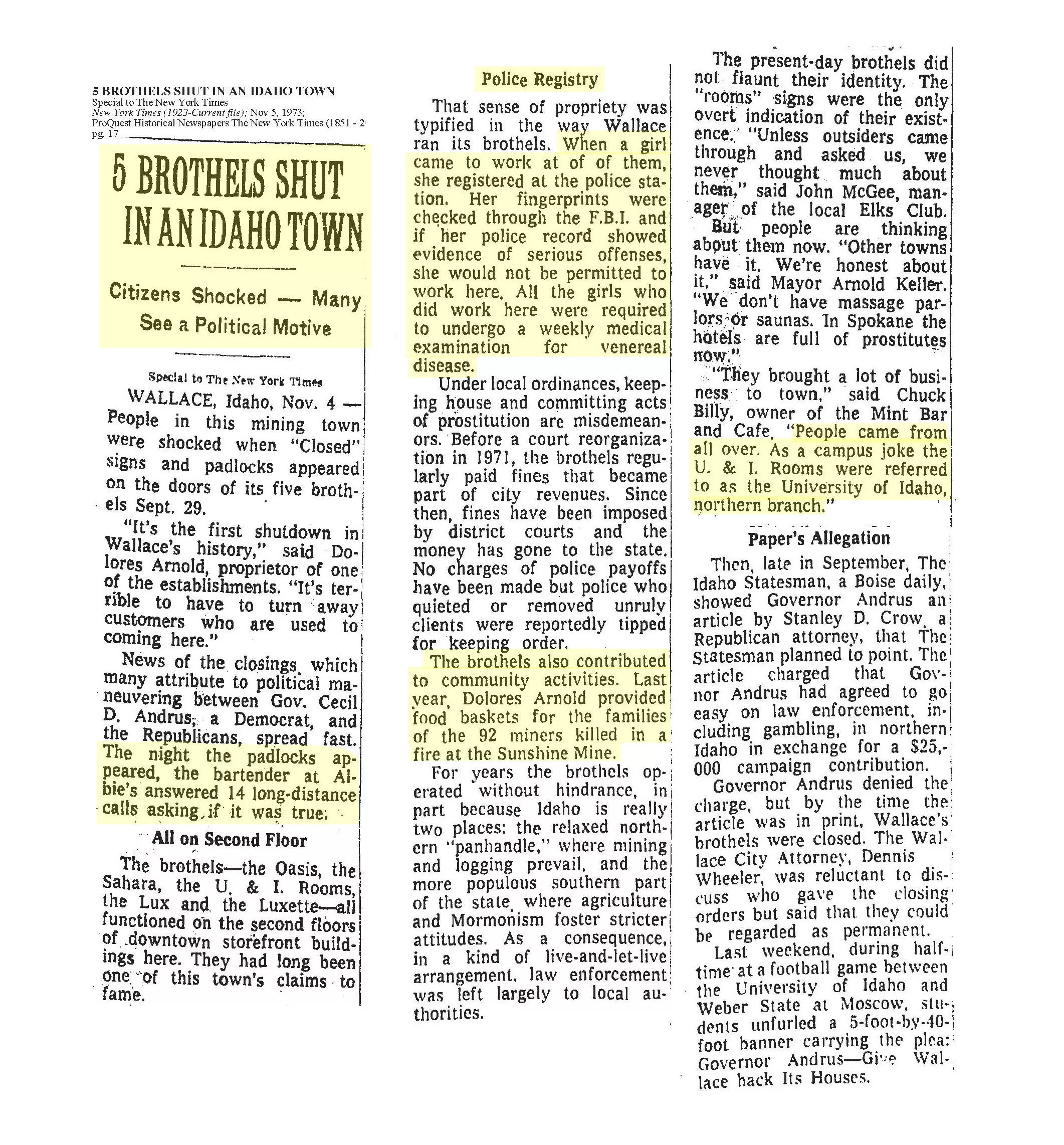
In the late 1960s-70s, the structure and physical locations of the brothels began to change, making way for Ginger of the Oasis and Lee Martin of the U&I to assume greater leadership roles. Ginger took over management of the Oasis in 1963, and by 1966 she was also at least half owner of the Arment, although management there turned over and she remained madam at the Oasis. Luoma sold the Jade to Dolores in 1967 (she got married and moved to Seattle, Tacoma, or Portland, depending who you talk to), and Dolores expanded there, calling her new house the Luxette, causing people to joke that she now had a franchise operation.
So during this time, there were five established houses: The Lux, on 6th street with access from Kelly’s Alley, The Arment at 601 ½ Cedar, The Oasis, The Jade and then Luxette at 611 ½ Cedar, and the U&I Rooms above 613 Cedar.
[According to police records there was a house called the Sahara that employed four girls during the year of 1973, but nobody really seems to remember this house, and it’s possible that the Oasis operated under this name for a brief time of back-stairs-entry-only during the temporary closure of 1973. That’s just an educated guess, because during this year, there was a change in Idaho law and federal policy, which led to a brief shutdown. So-called ‘moral crusaders’ began in southern Idaho and worked their way north to enforce new anti-prostitution laws on the books. The houses shut down for a while, taking their signs down and putting padlocks on the doors for show. They reopened quietly after a short time, and operated in a more underground way for a while. Dolores apparently operated the Lux as a ‘massage parlor’ for a short period of time during this year, until concerns subsided and operations resumed as before, in an open secret, regionally accepted manner.]
Police regulation appears to have ended in 1973, although the madams still enjoyed protection and continued donating money into a community fund managed by the chamber of commerce. Later claims that this amounted to bribery and corruption were not substantiated during two subsequent trials’it would be a misunderstanding of the community attitude and the legal evidence to interpret the arrangement the madams had with the town as anything other than mutually beneficial, reciprocal, and according to a 1977 study, embraced by 75-80 percent of Wallace citizens.
In 1977, the State of Idaho bought the building the Lux was in, because there were talks about the freeway coming through town there, and so that house moved to 601 ½ Cedar St., causing the permanent closure of the Arment Rooms, which Dolores remodeled using gold-colored paint for the trim. Lee Martin assumed management of the U&I in the 1960s or early 1970s and her approach to keeping the girls happy while working was to provide them with a social life[xlv]; during the 1970s-80s she ensured the boys around town would come up and hang out in the kitchen, and some of them became so close that they called themselves ‘the family.’[xlvi] Although you didn’t see the girls out at the bars around town, they did socialize more during the later years, and developed friendships with local women as well.[xlvii] Tanya took over most of the management work at the U&I by 1985, and this house outlasted the others. The Oasis shut down in January of 1988, the Lux and Luxette closed around the same time, due to Dolores’s Alzheimer’s disease increasing in severity, and finally in September of 1990 the U&I was mostly closed. It remained open in a quieter way until early June of 1991, when, according to at least one account, an FBI agent confessed to Tanya ‘in a moment of weakness,’ warning her that a large raid would soon take place, and they should leave town for good.[xlviii] Word is everything had mostly died down anyway, that the local economy could no longer support the workforce it had previously (unemployment soared to between 20-40%) and AIDS had really put a damper on the demand for the girls’ work, so the time was over, and Wallace transitioned into a tourism community, moving from selling sex to selling the past. Later that year, as the freeway began moving in overhead, the town buried its last literal red light and hauled the depot across the river to the area formerly home to its last figurative red light.
[i] Powell, 41. She cites: Wallace Press, 7 February 1891.
[ii] Powell, 40. She cites: Shoshone County Court House, Mortgage Books J and K; Coeur d’Alene Miner, 25 October, 1890; “Delinquent Tax List,” Coeur d’Alene Miner, 27 December 1890; “Delinquent Tax List of Wallace,” Wallace Press, 28 February, 1891; and Wallace Press, 20 December 1890. Wallace Press, 20 December 1890; and Mortgage Book J. Shoshone County Court Houses, Mortgage Books I, J, and K. Wallace Press, 20 December 1890 (Powell 94).
[iii] Powell 51
[iv] Powell 43. She cites: City of Wallace, Idaho, Police Record Journal, April 1893 – June 1908.
[v] Sanborn Fire Insurance Maps, Wallace, Idaho, 1901 and City of Wallace, Journal of Council Proceedings, March 1897 to 14 October 1901, Council Minutes for 27 May 1901.
[vi] Powell 99-100. The Arcade” was a combination of a bawdy theater and dance hall. See also Powell chapter five.
[vii] City of Wallace, City Council Proceedings Journal, March 1897 to 14 October 1901. Minutes of Council Chamber, 26 November 1900, qtd. in Powell 104
[viii] Powell 96
[ix] Powell 46 and 99
[x] Powell 43
[xi] Powell 43. She cites: Wallace Press, 30 March 1901.
[xii] ‘To Shut Off Red Lights.’ The Spokesman-Review, 19 May, 1903.
[xiii] ‘To Shut Off Red Lights.’ The Spokesman-Review, 19 May, 1903.
[xiv] ‘To Shut Off Red Lights.’ The Spokesman-Review, 19 May, 1903.
[xv] ‘Obey Order of Wallace Mayor’ The Spokesman-Review, 22 May, 1903.
[xvi] ‘Obey Order of Wallace Mayor’ The Spokesman-Review, 22 May, 1903.
[xvii] Powell 104
[xviii] City of Wallace, City Council Record Book, 28 October 1901 to 10 September 1906, Minutes of Council Chamber, 24 April 1905, qtd. in Powell 104-105.
[xix] 30 July 2014, Wallace, Idaho, Personal Interview.
[xx] Daily Idaho Press, 3 May 1909, Powell 100.
[xxi] Powell 143
[xxii] Powell 144, see also Smith’s thesis
[xxiii] Daily Idaho Press, 6 November 1909, qtd. in Powell 107
[xxiv] Powell 48.
[xxv] Powell 47-48.
[xxvi] Spokesman Review, August 1909, quoted in Hart and Nelson, Mining Town: The Photographic, Record of T.N. Barnard and Nellie Stockbridge from the Coeur d’Alenes, 138.
[xxvii] Idaho Press, 6 December 1906, qtd. in Powell 48.
[xxviii] Shoshone County Court House, District Court Office, Index to Register ofCriminal Actions; Proceedings Book B, No 497, qtd. in Powell 48.
[xxix] Ibid., Proceedings Book B, No. 495 and 496, cited in Powell 48.
[xxx] U.S. Census, 1910: State of Idaho, cited in Powell 48.
[xxxi] ‘A Child’s-Eye View,’ April 29, 2001, Wallace District Mining Museum Archives, ‘History of Wallace’ folder, filing drawer labeled ‘Historic.’ Justin Rice described the restricted district behind a gate during this time as well. He also mentioned a place called the Metropolitan Hotel as a brothel, and there is some evidence for that in the court records.
[xxxii] Barton, (Henry Kottkey) ‘Appendix B: Informant Transcriptions,’ p. 151
[xxxiii] Barton, ‘Appendix B: Informant Transcriptions,’ p. 152
[xxxiv] Barton, (Maidell Clemets) ‘Appendix B: Informant Transcriptions,’ p. 323-324
[xxxv] Wallace City Council Minute Book 1931-1939, p. 423
[xxxvi] Ibid.
[xxxvii] Ibid., p. 424. The legal description for the Flood properties was, ‘partly on lot 7 and on an unnumbered lot in rear of lots 5, 6, and 7 on Block 23,’ which would make these buildings right behind and moving toward the East of where the Oasis (lot 5) is today.
[xxxviii] Wallace City Council Minute Book 1931-1939, p. 501
[xxxix] Mike Feiler, Telephone Interview, 16 August, 2010.
[xl] Ibid.
[xli] Barton, ‘Appendix B: Informant Transcripts,’ 39
[xlii] Ordinance #292, Wallace City Council Minute Book 13 February 1939-16 September 1947, 24 March 1947, pgs 1024-1028.
[xliii] Wallace City Council Minute Book 13 February 1939-16 September 1947, 24 March 1947, pg 1028
[xliv] Francis, ‘Wages of Sin.’
[xlv] Mooney Interview
[xlvi] Roberts Interview
[xlvii] Kristi Gnaedinger 2014
[xlviii] Sue Hansen Interview’both 2010 and 2014
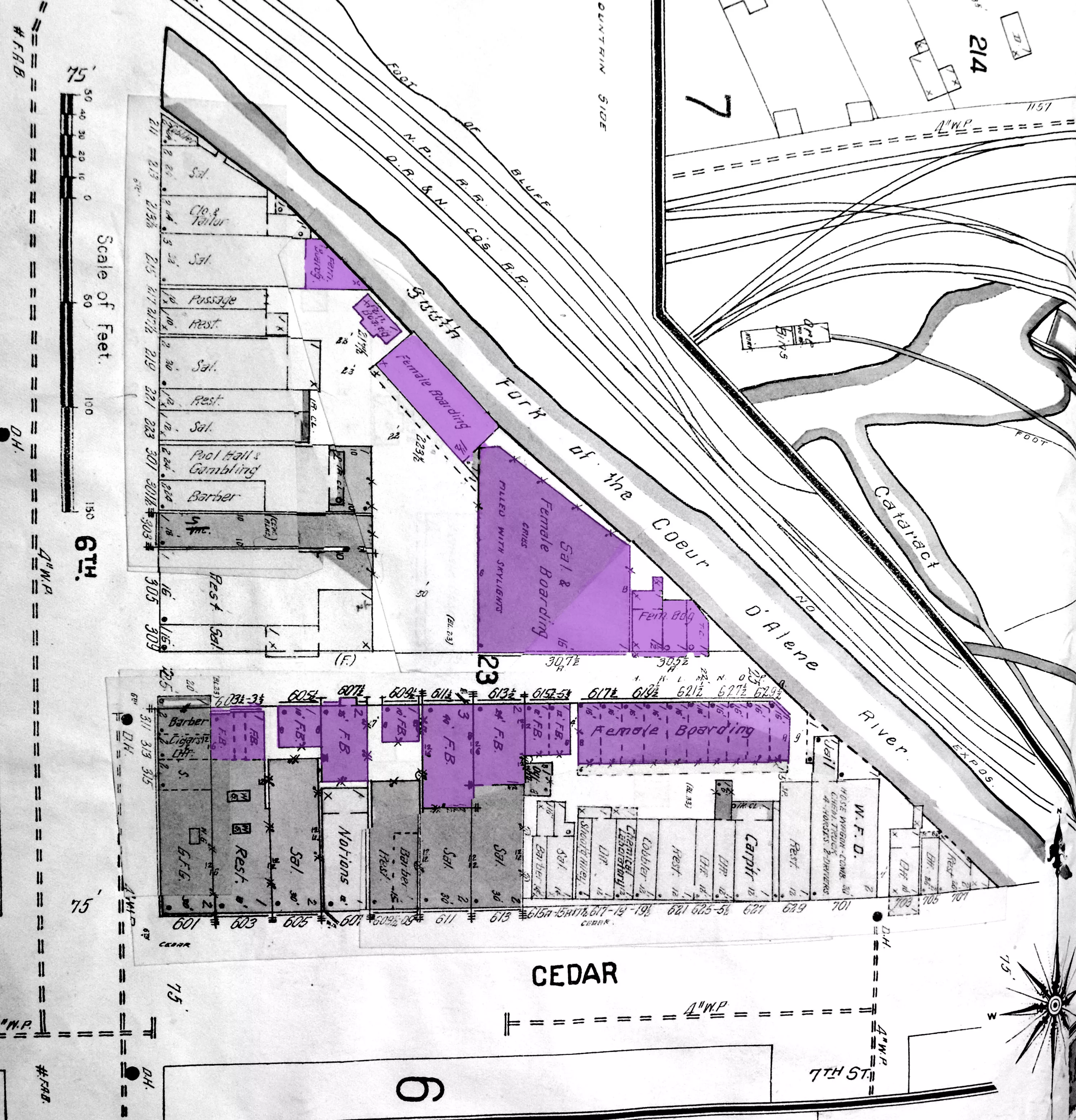
Leave a Reply